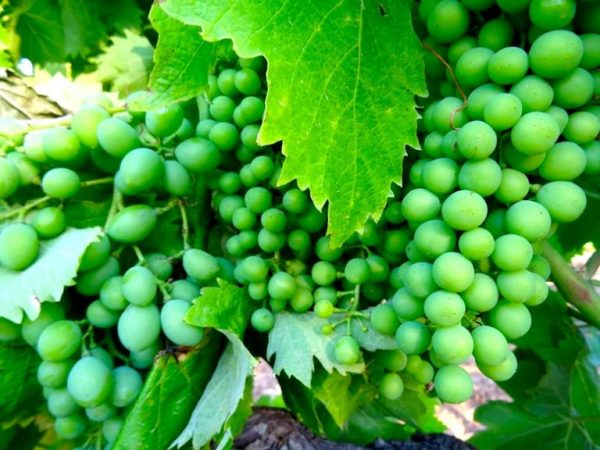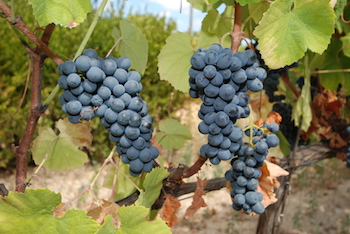With so many different varieties of Portuguese grapes we do not want to overwhelm readers with detailed descriptions of all of the varieties. However, below are descriptions of some of our favourite and some of the key grape varieties used in the production of Portuguese wine. All of these wonderful varieties add unique character to the wines of Portugal and they play their part in making Portuguese wine so exciting.

Portuguese grape varieties used in the production of white wines
Alvarinho – This is a highly prized variety of grape mainly grown in the North-west of Portugal. The grape is known as Albariño in Spain and it produces crisp, aromatic wines with notes of apple, peach, passion fruit, lychee and citrus fruits. The grape has a mineral character too. Alvarinho wines are excellent young, but they also age very well, often for ten years or more. Compared to other Vinho Verdes, Alvarinho makes more full-bodied wines that are often higher in alcohol.
Antão Vaz – This is a variety of grape that is hugely popular in the Alentejo region. The grape thrives in warm conditions with plenty of sunshine. The grapes typically produce wines that are full-bodied with notes of tropical fruits and tangerine peel. When picked early Antão Vaz are often crisp with good acidity; when left to ripen for longer the grapes can produce wines with high levels of alcohol.
Arinto – This variety of the Portuguese grapes is commonly grown in many parts of the country. The grape produces vibrant, fresh, dry, tangy wines with notes of lime and lemon. The grape is also known as Padernã in the Vinho Verde region. The wines produced with Arinto grapes can keep well but they are also fantastic when young. The prevalent acidity means that Arinto works exceptionally well in sparkling wines.
Bical – This is a grape vartiety that is typically grown in the regions of the Bairrada and the Dão. The grape is often used in sparkling wines. The wines produced are renowned for being well structured, soft and aromatic with notes of apricot and peach.
Encruzado – This is a superb grape currently exclusively grown in the Dão region. The wines produced are known for their mineral qualities and aromas of roses and violets. Encruzado is renowned for maintaining an exceptional balance between sweetness and acidity that enables wines of excellent structure that will keep and improve with time.
Fernão Pires – This grape (also known as Maria Gomes in the Bairrada region) is one of the most popular in Portugal. The grape is versatile and it makes crisp, aromatic wines often with low acidity. Citrus notes of lemon, lime, tangerines and oranges persist. Fernão Pires is also often used in sparkling wine production and it is also harvested late in the year to make sweet wines.
Loureiro – This is one of the more fragrant of the Portuguese grapes, it is commonly used to make Vinho Verde. The grape is known for its scents of orange flower, acacia, linden, apple and peach. Loureirio can help to give wines good structure and well-balanced acidity.
Moscatel Graúdo – This is the grape variety commonly known as Muscat of Alexandria and it is used in the production of the famous sweet, fortified wine Moscatel de Setúbal. A variety introduced by the Romans in the times of the Iberian invasions the grape is renowned for its powerful aromas of lychee, raisins, pear, lemon and lime flower.
Rabigato – This variety is extremely popular in the Douro Superior region of Portugal. The grape is typically used in blends to give light, refreshing acidity to the wines. We find this to be one of the most exciting of the Portuguese grapes.
Trajadura – A grape originating from the north of the Vinho Verde region, Trajadoura is known for its low acidity and the strength of the alcohol produced – higher than most varieties used in the region. The grape produces aromatic wines with notes of peach, apricot, apple, pear and orange blossom.
Verdelho – This is the variety of Portuguese grape that is used to produce the famous medium-sweet Madeira fortified wine. The grape can also be used to produce soft full-bodied table wines. Verdelho is now often used in Australia where it is known for producing rich, aromatic, dry white wines.
Viosinho – This is a grape variety that has been growing in popularity in recent years. Wine makers of the Douro region have recognised the potential of the grape for adding body and refreshing fragrance to wines as well as balance.
Portuguese grape varieties used in the production of red wines
Alfrocheiro – This is a grape that originates from the Dão region. Though not widely planted, this is one of the most popular of the Portuguese grapes with winemakers as it produces deep-coloured, well-balanced wines. The grapes produce aromas of blackberries and ripe strawberries.
Baga – Baga wines are renowned for being challenging to produce well but when the conditions are right the results can be exceptional. The grape is grown widely throughout the Bairrada region where the conditions for the grape are excellent. The skin of the grape is thick and this makes for wines that are high in tannins. The wines are particularly good for ageing and given time the tannins soften and the wines become elegant with notes of dried fruits.
Castelão – This is one of the most popular of the grape varieties in Portugal, particularly in the south where it is known as Periquita. The plants thrive in warm conditions so they are often seen in the regions of Tejo, Lisboa, Alentejo and the Setúbal Peninsula. The grape is recognised for giving structure to wines with good tannins and acidity. Aromas of redcurrants, preserved plums and berries are typical.
Jaen – This is a fantastic though one of the more challenging of the Portuguese grapes to grow. Jaen is often grown in the Dão region. The grapes ripen early and when successful the wines are well perfumed with notes of cherry, blackberry and blueberry.
Tinta Barroca – One of the 5 grapes typically used for Port production, this is one of the Portuguese grapes that has become a key ingredient of many of the wines produced in the Douro region. The vines have good resistance to diseases and the yields are comparatively high. The skin of the grape is thin and dark and the grapes are sweet with the potential to produce wines of high alcohol. The wines typically have fruity aromas of plum and cherry.
Tinta Cão – Another one of the 5 key grape varieties used in the Douro for Port production this is a grape that dates back to the 18th century. The skins of the Tinta Cão grapes are thick and they produce rich tannins and colour. The grape is renowned for producing the ideal balance between tannins, acidity and sugar; the wines have excellent structure with floral notes. The grapes produced are very late ripening and unfortunately the yields are exceptionally low – as such, for economic reasons many producers would avoid using this grape.
Tinta Roriz – Also known as Aragonês in Portugal and Tempranillo in Spain, this is a grape that is growing ever more popular in Portugal. The grape is recognised for adding body and elegance to wines; it also adds a delicious hint of spice. Tinta Roriz is typically blended with varieties such as Touriga Nacional, Touriga Franca, Trincadeira and Alicate Bouschet.
Touriga Franca – Renowned as one of the 5 key grape varieties for Port production, Touriga Franca has become the most widely planted grape of the Douro region and its popularity has spread throughout many of the northern parts of Portugal. With its dark skin the grape adds intense fruit flavour and body to wines along with floral aromas including roses and wild flowers. Touriga Franca is very often blended with Tinta Roriz and Touriga Nacional and it adds great elegance and ageing potential thanks to the velvety tannins.

Touriga Nacional grapes at the Falorca winery in the Dão
Touriga Nacional – This is without doubt the best known of the Portuguese grape varieties and rightly so. Touriga Nacional is used throughout Portugal in the different wine producing regions. The grape has been used for many years in the production of Port though now it is recognised for what it brings to table wines too. Often the grape is used on its own to make wines that showcase its qualities but also it is very often found in blends adding fantastic flavour and body to the wines. Touriga Nacional grapes are small and they have a high concentration of colour, sweetness and aroma (powerful fruit, blackcurrants, raspberries, liquorice and floral notes of violets). The skin of the grape is thick and tannic which can make it ideal for longer-term ageing.
Trincadeira – Also known as Tinta Amarela; this is one of the most widespread of the Portuguese grape varieties and it makes rich, dry reds with flavours of blackcurrant and floral aromas. The vine is renowned for being difficult to grow as it is susceptible to disease and it needs constant attention. Typically the vines perform better in the hot, dry regions such as the Alentejo and the Tejo. Althopugh difficult to get right, when Trincadeira is grown correctly the wines produced are typically of exceptional quality.
The following sites have been used to help us to write this piece. We recommend both sites for further research:
http://www.thewinesociety.com/Explore-regions-focus-grapesport
